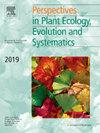人为干扰对抗媒介种子传播服务的有害影响:一项全球荟萃分析
IF 2.9
3区 环境科学与生态学
Q1 ECOLOGY
Perspectives in Plant Ecology Evolution and Systematics
Pub Date : 2025-05-22
DOI:10.1016/j.ppees.2025.125876
引用次数: 0
摘要
人为干扰,特别是自然和半自然栖息地的丧失,对生态系统具有全球性影响,特别是影响重要的生态服务,如蚂蚁的种子传播,这对大约4.5% %的植物物种至关重要。这些影响取决于生物群的生物地理起源、植物生长形式、植物和种子性状、相互作用的蚂蚁种类和当地站点特征等因素。在这项荟萃分析中,我们调查了人为干扰对蚂蚁介导的种子去除率和传播距离影响的总体趋势。我们还探讨了这些服务如何受到干扰类型、环境因素(如温度、降水和生物群系)、植物和种子性状(如扩散综合征,其与植物生长形式和种子大小的相互作用)以及传播者物种特征(如关键物种)的影响。我们分析了76项独立研究,包括430项与种子传播服务相关的实验(353项关注种子去除率,77项关注种子传播距离)。我们的研究结果表明,人为干扰对种子去除率有负面影响,尽管在所有非生物和生物环境中并不一致,但对种子传播距离没有显著影响。干扰与种子去除率的关系受干扰类型、生物群系、植物和种子性状的影响。具体来说,采矿活动降低了种子清除率,而干扰总体上减少了蚂蚁在地中海森林、林地、沙漠和干旱灌木地的种子清除。有趣的是,与其他植物生长形式或传播综合征相比,蜜树在种子清除方面特别脆弱,这表明干扰对抗虫介导的种子传播的影响可能导致森林生态系统结构的重大改变。我们的研究强调了保护抗虫媒介种子传播的重要性,特别是在昆虫热点地区,以保护这一重要的生态服务。本文章由计算机程序翻译,如有差异,请以英文原文为准。
Detrimental effects of anthropogenic disturbances on ant-mediated seed dispersal services: A global meta-analysis
Anthropogenic disturbances, particularly the loss of natural and semi-natural habitats, have global impacts on ecosystems, notably affecting vital ecological services like seed dispersal by ants, which are crucial for about 4.5 % of plant species. These effects depend on factors such as biogeographical origins of the biota, plant growth form, plant and seed traits, interacting ant species, and local site characteristics. In this meta-analysis, we investigated the overall trends in the impact of anthropogenic disturbances on ant-mediated seed removal rates and dispersal distances. We also explored how these services are influenced by disturbance type, environmental factors (e.g., temperature, precipitation, and biome), plant and seed traits (e.g., dispersal syndrome, its interaction with plant growth form, and seed size), and disperser species characteristics (e.g., keystone species). We analyzed 76 independent studies, comprising 430 experiments related to seed dispersal services (353 focused on seed removal rates and 77 on seed dispersal distances). Our findings revealed that anthropogenic disturbances negatively impact seed removal rates, although not consistently across all abiotic and biotic contexts, while having no significant effects on seed dispersal distances. The relationship between disturbances and seed removal was influenced by disturbance type, biome, plant and seed traits. Specifically, mining activities decreased seed removal rates, and disturbances in general reduced seed removal by ants in Mediterranean forests, woodlands, deserts and xeric shrublands. Interestingly, myrmecochorous trees were especially vulnerable in seed removal compared to other plant growth forms or dispersal syndromes, suggesting that the impacts of disturbance on ant-mediated seed dispersal could lead to major modifications in the structure of forest ecosystems. Our study highlights the importance of conserving ant-mediated seed dispersal, particularly in myrmecochory hotspots, to protect this critical ecological service.
求助全文
通过发布文献求助,成功后即可免费获取论文全文。
去求助
来源期刊
CiteScore
6.50
自引率
0.00%
发文量
28
审稿时长
67 days
期刊介绍:
Perspectives in Plant Ecology, Evolution and Systematics (PPEES) publishes outstanding and thought-provoking articles of general interest to an international readership in the fields of plant ecology, evolution and systematics. Of particular interest are longer, in-depth articles that provide a broad understanding of key topics in the field. There are six issues per year.
The following types of article will be considered:
Full length reviews
Essay reviews
Longer research articles
Meta-analyses
Foundational methodological or empirical papers from large consortia or long-term ecological research sites (LTER).

 求助内容:
求助内容: 应助结果提醒方式:
应助结果提醒方式:


